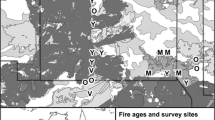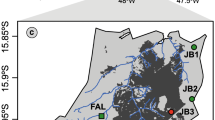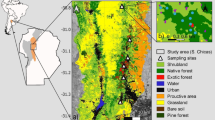Abstract
Savanna ecosystems are maintained by fires with a fire-adapted biota, and savannas occur in Amazonia in patches surrounded by tropical forest. Different fire regimes can generate structurally diverse vegetation, and the composition of savanna bird assemblages is known to be closely related to vegetation structure. However, long-term approaches and interaction of fire with other environmental factors need to be explored for the better understanding of the effects of fire on birds. In an Amazonian landscape composed by savanna and forest, we investigated the effects of different fire regimes in a 12-ha area in three periods through 23 years. We also examined the effects of frequency and extent of fires, tree cover, and distance to forest on bird composition in twelve 3.7-ha savanna plots. Birds were surveyed with mist-nets and species were classified as to their habitat use by their frequency of registers in forest and savanna plots in visual/acoustical surveys. After 13 years without fire, many forest species colonized the area and some savanna species were lost. After one fire event in a plot that had not burned for 12 years, some savanna species returned. These results highlight the effects of fire regime on birds and indicate that many savanna bird species depend on the occurrence of regular fires.





Similar content being viewed by others
Data availability
The html with the scripts will be provided as supplementary material and the script and tables used here are available at mega.
References
Abreu RCR, Hoffmann WA, Vasconcelos HL, Pilon NA, Rossatto DR, Durigan G (2017) The biodiversity cost of carbon sequestration in tropical savanna. Sci Adv 3:e1701284
Adeney JM, Christensen NL, Vicentini A, Cohn-Haft M (2016) White-sand ecosystems in Amazonia. Biotropica 48:7–23
Akaike H (1974) A new look at the statistical model identification. In: Parzen E, Tanabe K, Kitagawa G (eds) Selected papers of Hirotugu Akaike. Springer, New York, pp 215–222
Aleixo A, Poletto F (2007) Birds of an open vegetation enclave in southern Brazilian Amazonia. Wilson J Ornithol 119:610–630
Andersen AN, Hoffmann BD (2011) Conservation value of low fire frequency in tropical savannas: ants in monsoonal northern Australia. Austral Ecol 36:497–503
Andersen AN, Cook GD, Corbett LK, Douglas MM, Eager RW, Russell-Smith J, Setterfield SA, Williams RJ, Woinarski JCZ (2005) Fire frequency and biodiversity conservation in Australian tropical savannas: implications from the Kapalga fire experiment. Austral Ecol 30:155–167
Artman VL, Hutchinson TF, Brawn JD (2005) Fire ecology and bird populations in eastern deciduous forests. Stud Avian Biol 30:127–138
Azevedo JAR, Collevatti RG, Jaramillo CA, Strömberg CAE, Guedes TB, Matos-Maraví P, Bacon CD, Carillo JD, Faurby S, Antonelli A (2020) On the young savannas in the land of ancient forests. In: Rull V, Carnaval AC (eds) Neotropical diversification: patterns and processes. Springer, Cham, pp 271–298
Barlow J, Peres CA (2004) Avifaunal responses to single and recurrent wildfires in Amazonian forests. Ecol Appl 14:1358–1373
Bolker B, Bolker MB (2017) Package ‘bbmle.’ Tools for general maximum likelihood estimation 641: R package version 0.9, 5
Bond WJ, Keeley JE (2005) Fire as a global ‘herbivore’: the ecology and evolution of flammable ecosystems. Trends Ecol Evol 20:387–394
Camill P, Barry A, Williams E, Andreassi C, Limmer J, Solick D (2009) Climate-vegetation-fire interactions and their impact on long-term carbon dynamics in a boreal peatland landscape in northern Manitoba, Canada. J Geophys Res Biogeosci. https://doi.org/10.1029/2009JG001071
CBRO (2011) Listas das aves do Brasil. http://www.cbro.org.br. Acesso em 3:2012
Cintra R, Sanaiotti TM (2005) Fire effects on the composition of a bird community in an Amazonian savanna (Brazil). Braz J Biol 65:683–695
Cintra R, Magnusson WE, Albernaz A (2013) Spatial and temporal changes in bird assemblages in forest fragments in an eastern Amazonian savannah. Ecol Evol 3(10):3249–3262
Clavero M, Brotons L, Herrando S (2011) Bird community specialization, bird conservation and disturbance: the role of wildfires. J Anim Ecol 80:128–136
Crawford DN (1979) Effects of grass and fires on birds in the Darwin area, Northern Territory. Emu-Austral Ornithol 79:150–152
Crawley MJ (2007) Generalized linear models. In: The R book. pp 511–526. https://doi.org/10.1002/9781118448908.fmatter
da Silva JMC (1995) Avian inventory of the Cerrado region, South America: implications for biological conservation. Bird Conserv Int 5:291–304
da Silva JMC, Bates JM (2002) Biogeographic patterns and conservation in the South American Cerrado: a tropical savanna hotspot: the Cerrado, which includes both forest and savanna habitats, is the second largest South American biome, and among the most threatened on the continent. BioScience 52:225–234
Dambros CS (2014) poncho.R. figshare. Software
Davis MA, Miller A (2018) Savanna restoration using fire benefits birds utilizing dead trees, up to a point. Am Midl Nat 179:94–104
de Area Leão Pereira EJ, Ferreira PJS, de Santana Ribeiro LC, Carvalho TS, de Barros Pereira HB (2019) Policy in Brazil (2016–2019) threaten conservation of the Amazon rainforest. Environ Sci Policy 100:8–12
de Carvalho WD, Mustin K (2017) The highly threatened and little known Amazonian savannahs. Nat Ecol Evol 1:1–3
de Medeiros MB, Miranda HS (2005) Mortalidade pós-fogo em espécies lenhosas de campo sujo submetido a três queimadas prescritas anuais. Acta Bot Bras 19:493–500
de Sousa J et al (2022) Bird species responses to forest-savanna boundaries in an Amazonian savanna. Avian Conserv Ecol. https://doi.org/10.5751/ACE-02138-170130
de Souza Campos AC, Jardim MAG (2020) Composição florística da regeneração de um trecho de savana na Amazônia Oriental. Revista Brasileira de Geografia Física 13:2777–2787
de Souza Ferreira RQ, Camargo MO, de Souza PB, de Andrade VCL (2015) Fitossociologia e estrutura diamétrica de um cerrado sensu stricto, Gurupi, TO. Revista Verde de Agroecologia e Desenvolvimento Sustentável 10:36
Driscoll DA, Lindenmayer DB, Bennett AF, Bode M, Bradstock RA, Cary GJ, Clarke MF, Dexter N, Fensham R, Friend G (2010) Fire management for biodiversity conservation: key research questions and our capacity to answer them. Biol Conserv 143:1928–1939
Durigan G (2020) Zero-fire: not possible nor desirable in the Cerrado of Brazil. Flora 268:151612
Fidelis A, Pivello VR (2011) Deve-se usar o fogo como instrumento de manejo no Cerrado e Campos Sulinos? Biodiversidade Brasileira-BioBrasil 1(2):12–25
Fidelis A, Zirondi HL (2021) And after fire, the Cerrado flowers: a review of post-fire flowering in a tropical savanna. Flora 280:151849
Furley P (2006) Tropical savannas. Prog Phys Geogr 30:105–121
Garzón-Orduña IJ, Benetti-Longhini JE, Brower AVZ (2014) Timing the diversification of the Amazonian biota: butterfly divergences are consistent with Pleistocene refugia. J Biogeogr 41:1631–1638
Griffiths AD, Christian KA (1996) The effects of fire on the frillneck lizard (Chlamydosaurus kingii) in northern Australia. Aust J Ecol 21:386–398
Hirota M, Holmgren M, Van Nes EH, Scheffer M (2011) Global resilience of tropical forest and savanna to critical transitions. Science 334:232–235
Hoffmann WA, Orthen B, Franco AC (2004) Constraints to seedling success of savanna and forest trees across the savanna-forest boundary. Oecologia 140:252–260
Kandlikar G (2021) Ranacapa: utility functions and “shiny” app for simple environmental DNA visualizations and analyses. R package version 01
Krook K, Bond WJ, Hockey PAR (2007) The effect of grassland shifts on the avifauna of a South African savanna. Ostrich J Afr Ornithol 78:271–279
Legendre P, McArdle BH (1997) Comparison of surfaces. Oceanol Acta 20:27–41
Lehmann CER, Archibald SA, Hoffmann WA, Bond WJ (2011) Deciphering the distribution of the savanna biome. New Phytol 191:197–209
Lehmann CER, Anderson TM, Sankaran M, Higgins SI, Archibald S, Hoffmann WA, Hanan NP, Williams RJ, Fensham RJ, Felfili J (2014) Savanna vegetation-fire-climate relationships differ among continents. Science 343:548–552
Lima JM, Castro AB, Lima AP, Magnusson WE, Landeiro VL, Fadini RF (2020) Influência do regime de queimadas sobre a riqueza e composição florística de uma savana isolada na Amazônia-PELD Oeste do Pará. Oecol Aust 24:301–316
Magnusson WE, Sanaiotti TM, Lima AP et al (2002) A comparison of δ13C ratios of surface soils in savannas and forests in Amazonia. J Biogeogr 29:857–863
Magnusson WE, Lima AP, Albernaz ALKM, Sanaiotti TM, Guillaumet J-L (2008) Composição florística e cobertura vegetal das savanas na região de Alter do Chão, Santarém-PA. Braz J Bot 31:165–177
Mata JR, Erize F, Rumboll M (2006) Birds of South America: non-passerines: rheas to woodpeckers. Princeton University Press, Princeton
McCune B, Grace JB, Urban DL (2002) Analysis of ecological communities. MjM Software Design, Gleneden Beach
Medeiros MB, Miranda HS (2008) Post-fire resprouting and mortality in cerrado woody plant species over a three-year period. Edinb J Bot 65:53–68
Miranda IS (1993) Estrutura do estrato arbóreo do cerrado amazônico em Alter-do-Chão, Pará, Brasil. Rev Bras Bot 16:143–150
Moreira AG (2000) Effects of fire protection on savanna structure in Central Brazil. J Biogeogr 27:1021–1029
Moura NG, Lees AC, Aleixo A, Barlow J, Berenguer E, Ferreira J, Mac Nally R, Thomson JR, Gardner TA (2016) Idiosyncratic responses of Amazonian birds to primary forest disturbance. Oecologia 180:903–916
Moustakas A, Wiegand K, Meyer KM, Ward D, Sankaran M (2010) Perspective: learning new tricks from old trees: revisiting the savanna question. Front Biogeogr. https://doi.org/10.21425/F5FBG12335
Murphy BP, Bowman DMJS (2012) What controls the distribution of tropical forest and savanna? Ecol Lett 15:748–758
Mustin K, Carvalho WD, Hilário RR, Costa-Neto SV, Silva C, Vasconcelos IM, Castro IJ, Eilers V, Kauano ÉE, Mendes-Junior RNG (2017) Biodiversity, threats and conservation challenges in the Cerrado of Amapá, an Amazonian savanna. Nat Conserv 22:107
Oksanen J, Blanchet FG, Kindt R, Legendre P, O’hara RB, Simpson GL, Solymos P, Stevens MHH, Wagner H (2010) Vegan: community ecology package. R package version 1.17-4. http://cran.r-project.org. Acesso em 23:2010
Parr CL, Andersen AN (2006) Patch mosaic burning for biodiversity conservation: a critique of the pyrodiversity paradigm. Conserv Biol 20:1610–1619
Parr CL, Chown SL (2003) Burning issues for conservation: a critique of faunal fire research in Southern Africa. Austral Ecol 28:384–395
Passos FB, Marimon BS, Phillips OL, Morandi PS, das Neves EC, Elias F, Reis SM, de Oliveira B, Feldpausch TR, Marimon Júnior BH (2018) Savanna turning into forest: concerted vegetation change at the ecotone between the Amazon and “Cerrado” biomes. Braz J Bot 41:611–619
Pennington RT, Lehmann CER, Rowland LM (2018) Tropical savannas and dry forests. Curr Biol 28:R541–R545
Piratelli A, Blake JG (2006) Bird communities of the southeastern Cerrado region, Brazil. Ornitol Neotrop 17:213–225
Pires J, Prance G (1985) The vegetation types of the Brazilian Amazon. Botan Rev 51(3):291–340
Pons P, Clavero M (2010) Bird responses to fire severity and time since fire in managed mountain rangelands. Anim Conserv 13:294–305
Prior LD, Williams RJ, Bowman DMJS (2010) Experimental evidence that fire causes a tree recruitment bottleneck in an Australian tropical savanna. J Trop Ecol 26:595–603
R Core Team (2021) R: a language and environment for statistical computing. R Foundation for Statistical Computing, Vienna
Ramos-Neto MB, Pivello VR (2000) Lightning fires in a Brazilian savanna national park: rethinking management strategies. Environ Manag 26:675–684
Rapozo P (2021) Necropolitics, state of exception, and violence against Indigenous people in the Amazon region during the Bolsonaro Administration. Braz Polit Sci Rev. https://doi.org/10.1590/1981-3821202100020003
Resende-Moreira LC, Knowles LL, Thomaz AT, Prado JR, Souto AP, Lemos-Filho JP, Lovato MB (2019) Evolving in isolation: genetic tests reject recent connections of Amazonian savannas with the central Cerrado. J Biogeogr 46:196–211
Ridgely RS, Tudor G (2009) Field guide to the songbirds of South America: the passerines. University of Texas Press, Austin
Ritter CD, Coelho LA, Capurucho JM, Borges SH, Cornelius C, Ribas CC (2021) Sister species, different histories: comparative phylogeography of two bird species associated with Amazonian open vegetation. Biol J Lin Soc 132(1):161–173. https://doi.org/10.1093/biolinnean/blaa167
Russell-Smith J, Price OF, Murphy BP (2010) Managing the matrix: decadal responses of eucalypt-dominated savanna to ambient fire regimes. Ecol Appl 20:1615–1632
Sanaiotti TM, Cintra R (2001) Breeding and migrating birds in an Amazonian savanna. Stud Neotrop Fauna Environ 36:23–32
Sanaiotti TM, Magnusson WE (1995) Effects of annual fires on the production of fleshy fruits eaten by birds in a Brazilian Amazonian savanna. J Trop Ecol 11:53–65
Santos MPD, Silva JMC (2007) As aves das savanas de Roraima. Rev Bras Ornitol 15:189–207
Sievert C (2020) Interactive web-based data visualization with R, plotly, and shiny. CRC Press, Boca Raton
Silva GE, Guilherme FAG, Carneiro SES, Pinheiro MHO, Ferreira WC (2019) Heterogeneidade ambiental e estrutura da vegetação arbustivo-arbórea em três áreas de Cerrado sentido restrito no sudoeste goiano. Ciênc Florest 29:924–940
Silva PS, Nogueira J, Rodrigues JA, Santos FLM, Pereira JMC, DaCamara CC, Daldegan GA, Pereira AA, Peres LF, Schmidt IB (2021) Putting fire on the map of Brazilian savanna ecoregions. J Environ Manag 296:113098
Silvestrini RA, Soares-Filho BS, Nepstad D et al (2011) Simulating fire regimes in the Amazon in response to climate change and deforestation. Ecol Appl 21:1573–1590
Sirami C, Monadjem A (2012) Changes in bird communities in Swaziland savannas between 1998 and 2008 owing to shrub encroachment. Divers Distrib 18:390–400
Sirami C, Seymour C, Midgley G, Barnard P (2009) The impact of shrub encroachment on savanna bird diversity from local to regional scale. Divers Distrib 15:948–957
Smit IPJ, Asner GP, Govender N, Kennedy-Bowdoin T, Knapp DE, Jacobson J (2010) Effects of fire on woody vegetation structure in African savanna. Ecol Appl 20:1865–1875
Sorrensen C (2009) Potential hazards of land policy: conservation, rural development and fire use in the Brazilian Amazon. Land Use Policy 26:782–791
Tubelis DP (2004) Species composition and seasonal occurrence of mixed-species flocks of forest birds in savannas in central Cerrado, Brazil. Ararajuba 12:105–111
Tubelis DP, Cavalcanti RB (2001) Community similarity and abundance of bird species in open habitats of a central Brazilian Cerrado. Ornitol Neotrop 12:57–73
van Els P, Zarza E, Rocha Moreira L et al (2021) Recent divergence and lack of shared phylogeographic history characterize the diversification of neotropical savanna birds. J Biogeogr 48:1124–1137
Vasconcelos HL, Leite MF, Vilhena JMS, Lima AP, Magnusson WE (2008) Ant diversity in an Amazonian savanna: relationship with vegetation structure, disturbance by fire, and dominant ants. Austral Ecol 33:221–231
Wickham H (2016) ggplot2: elegant graphics for data analysis. Springer, Cham
Wickham H (2017) Tidyverse: easily install and load “Tidyverse” packages (version R package version 1.1. 1)
Woinarski JCZ, Risler J, Kean L (2004) Response of vegetation and vertebrate fauna to 23 years of fire exclusion in a tropical eucalyptus open forest, Northern Territory, Australia. Austral Ecol 29:156–176
Xu X, Jia G, Zhang X et al (2020) Climate regime shift and forest loss amplify fire in Amazonian forests. Glob Chang Biol 26:5874–5885
Acknowledgements
We thank the Nobre brothers for support and dedication to the project, Mario Cohn-Haft for help in species identification and Paulo E.S. Massoca for the help with the production and analysis of maps. CDR aknowledge the Mulago Foundation for the supprt provided to Instituto Jurua. WEM received a productivity scholarship from CNPq.
Funding
We thank INPA for the support and CNPq for the scholarship for LAC’s MSc project. The long-term fire and avifauna data are financed by the productivity scholarships from CNPq and PPI-INPA to TMS and APL.
Author information
Authors and Affiliations
Contributions
LAC and TMS conceived the study; LAC, APL, RC, WEM and TMS collected data. LAC and CDR analyzed data and wrote the manuscript with contribution of all authors.
Corresponding authors
Ethics declarations
Competing interests
The authors declare no competing of interest.
Ethical approval
No ethical requirement was necessary. Birds captured in this study were marked with metal bands provided by CEMAVE-ICMBio (Authorization Number 1177/4, ICMBIO/SNA) or coloured plastic bands.
Additional information
Communicated by Grzegorz Mikusinski.
Publisher's Note
Springer Nature remains neutral with regard to jurisdictional claims in published maps and institutional affiliations.
Supplementary Information
Below is the link to the electronic supplementary material.
Rights and permissions
Springer Nature or its licensor (e.g. a society or other partner) holds exclusive rights to this article under a publishing agreement with the author(s) or other rightsholder(s); author self-archiving of the accepted manuscript version of this article is solely governed by the terms of such publishing agreement and applicable law.
About this article
Cite this article
Coelho, L.A., Duarte Ritter, C., Lima, A.P. et al. Effects of fire regime on the bird community in an Amazonian savanna. Biodivers Conserv 32, 3893–3913 (2023). https://doi.org/10.1007/s10531-023-02665-0
Received:
Revised:
Accepted:
Published:
Issue Date:
DOI: https://doi.org/10.1007/s10531-023-02665-0




